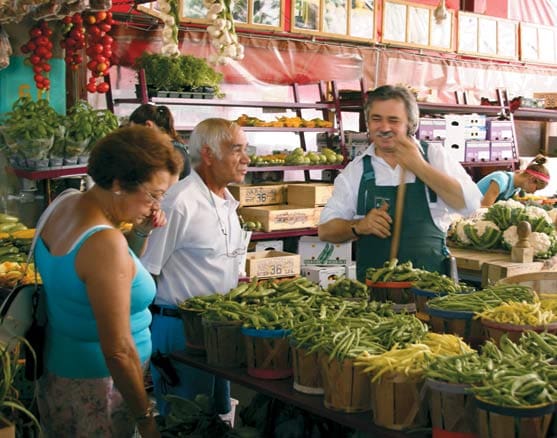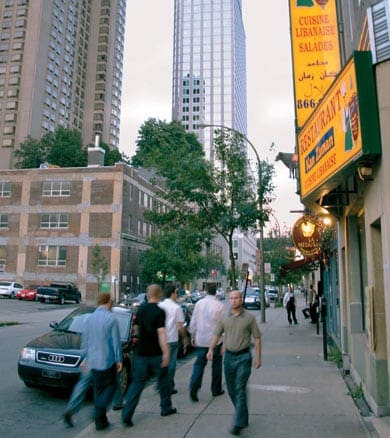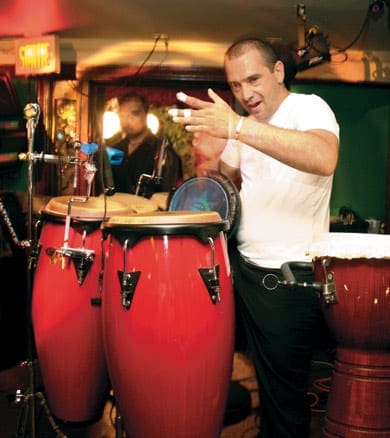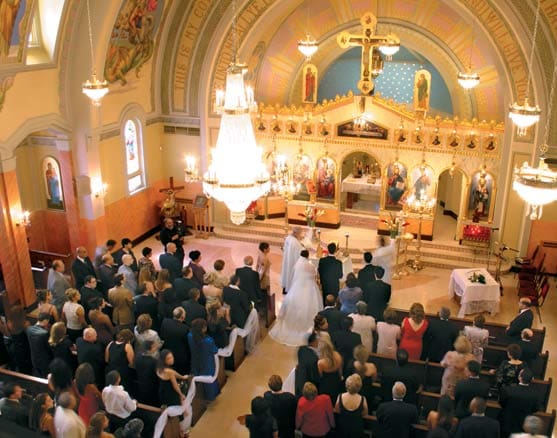








You will find them bowed in churches, whispering praise to “Allah” (God).
You will find them animated in cafes and bars, smoking water pipes and exclaiming “haram” (it’s a shame) over the latest injustice in the Holy Land or some bad call during a European soccer match.
You will find them seated in restaurants before plates of lamb sausages and salads, pounding their fists on tables and crying “mish maouleh” (impossible) in response to some devilishly tall tale.
You will find them frenzied near altars, elbowing their way to capture the perfect photograph of a loved one exchanging marriage vows and begging “lazza choue” (pardon me).
You will find them bellies bared in dance clubs, twisting their torsos and asking “in jeid?” (really) over the reported affection of some member of the opposite sex.
They are everywhere. They are Lebanese and they have found a home in Montréal.
That the most distinct people of the Middle East have found refuge and new life in the most distinct of Canada’s great cities should come as no surprise. The urbane, gregarious and multilingual Lebanese seem a natural fit for Québec’s cosmopolitan center, whose denizens fiercely protect their Francophone patrimony.
The Lebanese first arrived in Canada some 120 years ago. Since then, more than 250,000 have followed, with more than half settling in Montréal.
The first among them came as peddlers and merchants seeking fortune and a quick return home. They, along with others, would meet Canada’s need for people to tap the country’s natural resources, work in its factories and populate the vast frontier.
Subjects of an Ottoman Empire beset by the colonial ambitions of the Great Powers, the Lebanese saw Canada as a refuge from political instability and religious persecution in their homeland. They numbered four in 1883, an estimated 7,000 by 1911.
Such statistics, however, are not precise. Though most of these immigrants hailed from what is now Lebanese territory, the Canadian government first classified them as Syrian (Lebanon did not exist as a modern political entity until 1926) and then Syrian-Lebanese before eventually distinguishing between the two.
World wars and a global economic crisis, coupled with restrictive immigration policies, brought their inflow to a halt for 40 years, but the Lebanese did not stagnate or lose contact with their ancestral home.
Instead, they created vibrant religious, social and cultural institutions to secure their place in Canada’s diverse national landscape and keep alive a deep connection to their heritage.
An estimated 90 percent of all pre-World War II Lebanese immigrants to Canada were Christians – chiefly Orthodox, Maronite and Melkite Greek Catholics. At first, these religious communities consisted of little more than a roving priest shepherding a dispersed flock. As the communities and their needs grew, however, churches were established and became centers of community life.
These churches, which often served members of different Arab Christian communities, provided a common space for Lebanese and other Arab families to meet, speak Arabic, renew familial and communal ties and create other social institutions, be they media, professional or business-oriented.
Foundation. His chin stained with dried blood, Father Anthony Gabriel stood before his congregation at St. George Antiochian Orthodox Church on Rue Jean-Talon in northern Montréal. Having just celebrated the Divine Liturgy in a passionate but somber voice, he exhaled deeply.
Parishioners packed into the beautifully restored church seemed nervous.
Father Gabriel had experienced grave health problems over the last year. He had returned just the night before from the United States, where he had undergone high-risk surgery. His return, however, was also difficult. He had fallen down a flight of stairs, bloodying his face hours before the service.
“My doctors said I should not celebrate the liturgy today, but I wanted to be here with you, my people,” Father Gabriel said. He spoke in a steady and perfect English, common among Arab Orthodox who were excluded from French-speaking Catholic schools when Canada’s educational system was denominational.
“Thanks to God, my faith and some very good doctors in the United States, I have passed through a very difficult period,” he said, apologizing for dedicating the homily to his own story. “I now have new life and want to share those blessings with you.”
At the end of the service, which included English, French, Arabic and a bit of Byzantine Greek, the parishioners filed out the church doors, relieved to see their priest in better health and busy making brunch plans with family and friends.
Father Gabriel stood wearily before the iconostasis, greeting a few parishioners with hugs and kisses.
“We have a long and important history here,” he said, before retiring for rest.
The community dates its history to Canada’s first Syrian-Lebanese immigrants and was originally under the jurisdiction of the Patriarchate of Moscow. Members pledged allegiance to the Patriarch of Antioch in 1934, but struggled to overcome an earlier split into two separate parishes until a unity agreement was reached in 1955.
St. George’s, whose current structure was consecrated in 1940, quickly became the scene of pastoral and community activities. A choir was established, an office and schoolhouse added and religious educational programs and youth groups created.
From this community emerged leaders not only of the Arab Christian community of Montréal, but also captains of Canada’s political, social and economic life.
Father Gabriel was referring to St. George’s and the Antiochian Orthodox in Montréal when he mentioned their historic importance, but his words applied equally to his own leadership of the community.
Since he was appointed pastor of St. George’s in 1976, he has more than doubled the number of parishioners, bringing the current total to 1,200 families. A professor, media personality and social activist, Father Gabriel has worked hard to serve the Orthodox faith, the Arab Christian community in Montréal and all Canadians.
The church sponsors an international adoption agency, programs for the poor, a charitable foundation, a humanitarian fund and a home for the elderly.
Building on the historic strength and resources of the community, Father Gabriel is perhaps best known for his work in helping thousands of Lebanese flee their country during the darkest days of Lebanon’s civil war (1975-1990), offering refuge in Canada. His community provided refugees of every faith with basic necessities and eased their integration into Canadian life.
A community in flight. On the same day as Father Gabriel’s return to St. George’s, but to the northwest on Avenue Henri Bourassa, another celebration was taking place at the Cathedral of St. Maron.
Montréal’s Maronite community was preparing to welcome the marriage of two of its own, with Eparch of Saint-Maron de Montréal Joseph Khoury set to preside.
“We are running a little late,” said Father Sami, one of the cathedral’s two priests, “a la Libanaise.”
“The Lebanese style” was certainly on display, as it always is with this most extraordinary of Lebanese communities in Montréal.
Young men in sharply pressed suits and young women in tight-fitting gowns lingered about the enormous cathedral, a former Roman Catholic church, chatting on cell phones in French and Arabic and exchanging smiles amid flowers and white garlands under the warm glow of candlelight.
Countless cameramen crowded the couple to be married from the first moment they stepped out of their white stretch limousine until their departure.
Maronites also date their history in Montréal to the late 19th century (although many of the first Maronites were Egyptian) and are proud of their social activism in Canada over the last 100 years.
The community – its past, present and future – is the product, however, of the horrible sectarian war and political and economic order that have gripped Lebanon for the last 30 years.
“Lebanon and the Maronite community there were torn apart by the war. Many had to leave,” Bishop Joseph said. “Those who came here needed the community space to preserve their traditions and their tie to their mother country.”
Schooled in Lebanon’s French-speaking Catholic schools, many Maronites found Francophone Montréal an ideal choice for relocation, which the church in Canada actively assisted.
While political tensions remain in Lebanon and among the Lebanese diaspora over the war and its outcome, Bishop Joseph said the church in Canada focuses its efforts on strengthening the traditions and faith of their ancestral land.
“It is more important to instill pride in the youth about Lebanon. It is our land; we must not lose our attachment to it,” Bishop Joseph said. “Complaining about this or that doesn’t serve the youth, who need to have a sense of loyalty toLebanon and their faith.”
To strengthen this loyalty, the church organizes volunteer associations, cultural and youth groups and other activities.
Progress remains slow. Watermarks from a leaky roof, stained carpets and the occasional missing window speak to the eparchy’s financial difficulties.
“We don’t have financial revenues from organizations or enterprises. We have no schools, hospitals or land to make money,” said the bishop, who was born in northern Lebanon and was appointed in 1996 in an effort to rescue the church from a financial crisis.
“Many of our parishioners are refugees and have few financial resources, so the church depends on the generosity of wealthy individual donors, who come mostly from the Lebanese community in Montréal, both Maronite and non-Maronite.”
The bishop estimated that there are 10,000 Maronite families living in the Montréal area and another 10,000 across the country.
The Maronite community is also participating in dialogue to improve interfaith communication, a necessity given the influx of non-Christian Lebanese to Canada in the last 15 years.
“We are all immigrants, so we face many of the same social and economic challenges,” said Bishop Joseph.
“In the post-September 11 world,” he continued, “Arabs – Christian and Muslim – are joined by the same difficulties: official and nonofficial suspicion.”
Unity in diversity. Back at St. George’s, another wedding was taking place, but not an Orthodox one. Again the church was filled with Lebanese and other Arabs, but conducting the service in Arabic was Melkite Greek Catholic Eparch of Saint-Sauveur de Montréal Ibrahim Ibrahim.
Like the Maronite Church before it acquired its cathedral, the Melkite community in Montréal must use other churches for its services. For this day, they are gathered at St. George’s; regular Sunday services are held at Notre Dame des Anges in northwest Montréal.
The Melkite community in Montréal, which numbers some 4,000 families, also traces its lineage to the first Lebanese immigrants to Canada.
The first Melkite priest arrived in Montréal in 1901 to tend to this community. Some 20 years later, the community had grown large enough to purchase St. Sauveur Church in downtown Montréal.
“We are the oldest Middle Eastern Christian community in Montréal and Canada,” said Bishop Ibrahim, a great barrel of a man with bright eyes, a booming voice and a sharp intellect. “In the past, other communities, including the Orthodox, used our church and its services.”
A victim of cost management and the dispersal of the community to Montréal’s northern and western suburbs, St. Sauveur’s now stands abandoned and boarded up in the city’s financial district.
Bishop Ibrahim, who was appointed in 2003, said, however, that the experience of sharing resources at St. Sauveur’s continues to buttress strong relations among Montréal’s Arab Christian communities.
“We believe in the message of the Universal Church,” said the bishop, who was born in Jensnaya, a village east of Sidon in southern Lebanon. “As Melkites, our charism is openness; we are proud of it and we have been hard workers for unity and ecumenism.
The facilities at the cathedral include rooms with computers for catechism classes, which are taught in French. “Many of our younger members do not know Arabic, so we use French – with a little bit of Arabic for the sake of our traditions.” English is common in the 14 Maronite missions and parishes across Anglophone Canada.
The bishop has plans for a library and a residence for a religious order.
“It can, however, be a difficult balancing act,” the bishop said. “As Catholics, we very much support unity, but we want our children to know our traditions and have a sense of difference.”
The Melkite community in Montréal, possibly the largest outside the Middle East, has recently purchased property in St. Laurent, a northern suburb, to build a new church. In the future the bishop wants to divide the community in the Montréal area into four parishes.
“We are starting to restructure our pastoral means, team and tools with the hope that we will be better prepared to offer better services to our community, especially our youngest members,” said Bishop Ibrahim.
Like the leaders of the Orthodox and Maronite churches, the bishop avoids the politics that have divided the community’s native land and advocates that it play a prominent role in Canada.
“We are proud to be Canadians, just as we are proud of our distinct heritage,” the bishop said. Both Canadian and Lebanese? Just ask them; you will find them in Montréal.
David Sheehan, Assistant Editor of ONE, worked as a journalist in Beirut for two years.